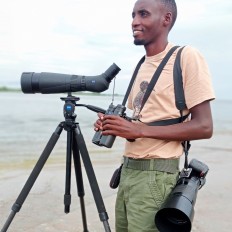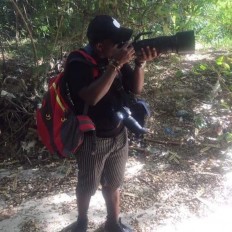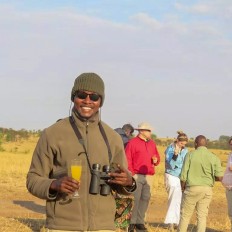Top species
- White-faced Whistling-Duck (Dendrocygna viduata)
- Red-necked Spurfowl (Pternistis afer)
- African Finfoot (Podica senegalensis)
- White-crowned Lapwing (Vanellus albiceps)
- Temminck's Courser (Cursorius temminckii)
- African Skimmer (Rynchops flavirostris)
- African Darter (Anhinga rufa)
- Great White Pelican (Pelecanus onocrotalus)
- Pink-backed Pelican (Pelecanus rufescens)
- Black-crowned Night Heron (Nycticorax nycticorax)
- White-backed Night Heron (Calherodius leuconotus)
- Goliath Heron (Ardea goliath)
- Glossy Ibis (Plegadis falcinellus)
- Palm-nut Vulture (Gypohierax angolensis)
- Lappet-faced Vulture (Torgos tracheliotos)
- Hooded Vulture (Necrosyrtes monachus)
- Rüppell's Griffon (Gyps rueppelli)
- Pallid Harrier (Circus macrourus)
- Pel's Fishing-Owl (Scotopelia peli)
- Pale-billed Hornbill (Lophoceros pallidirostris)
- Mangrove Kingfisher (Halcyon senegaloides)
- Böhm's Bee-eater (Merops boehmi)
- Madagascar Bee-eater (Merops superciliosus)
- Northern Carmine Bee-eater (Merops nubicus)
- Crested Barbet (Trachyphonus vaillantii)
- Stierling's Woodpecker (Dendropicos stierlingi)
- Reichenow's Woodpecker (Campethera scriptoricauda)
- Lesser Kestrel (Falco naumanni)
- Gray Kestrel (Falco ardosiaceus)
- Dickinson's Kestrel (Falco dickinsoni)
- Red-necked Falcon (Falco chicquera)
- Sooty Falcon (Falco concolor)
- Brown-headed Parrot (Poicephalus cryptoxanthus)
- Croaking Cisticola (Cisticola natalensis)
- Collared Palm-Thrush (Cichladusa arquata)
- Purple-banded Sunbird (Cinnyris bifasciatus)
- Southern Cordonbleu (Uraeginthus angolensis)
List up to ca. 25 species that:
• have a limited distribution range and/or are rare on a global level
• are most sought-after by birdwatchers at this site
• and are relatively easy to see at this site (year-round or seasonally)
| White-faced Whistling-Duck (Dendrocygna viduata) | |
| Red-necked Spurfowl (Pternistis afer) | |
| African Finfoot (Podica senegalensis) | |
| White-crowned Lapwing (Vanellus albiceps) | |
| Temminck's Courser (Cursorius temminckii) | |
| African Skimmer (Rynchops flavirostris) | |
| African Darter (Anhinga rufa) | |
| Great White Pelican (Pelecanus onocrotalus) | |
| Pink-backed Pelican (Pelecanus rufescens) | |
| Black-crowned Night Heron (Nycticorax nycticorax) | |
| White-backed Night Heron (Calherodius leuconotus) | |
| Goliath Heron (Ardea goliath) | |
| Glossy Ibis (Plegadis falcinellus) | |
| Palm-nut Vulture (Gypohierax angolensis) | |
| Lappet-faced Vulture (Torgos tracheliotos) | |
| Hooded Vulture (Necrosyrtes monachus) | |
| Rüppell's Griffon (Gyps rueppelli) | |
| Pallid Harrier (Circus macrourus) | |
| Pel's Fishing-Owl (Scotopelia peli) | |
| Pale-billed Hornbill (Lophoceros pallidirostris) | |
| Mangrove Kingfisher (Halcyon senegaloides) | |
| Böhm's Bee-eater (Merops boehmi) | |
| Madagascar Bee-eater (Merops superciliosus) | |
| Northern Carmine Bee-eater (Merops nubicus) | |
| Crested Barbet (Trachyphonus vaillantii) | |
| Stierling's Woodpecker (Dendropicos stierlingi) | |
| Reichenow's Woodpecker (Campethera scriptoricauda) | |
| Lesser Kestrel (Falco naumanni) | |
| Gray Kestrel (Falco ardosiaceus) | |
| Dickinson's Kestrel (Falco dickinsoni) | |
| Red-necked Falcon (Falco chicquera) | |
| Sooty Falcon (Falco concolor) | |
| Brown-headed Parrot (Poicephalus cryptoxanthus) | |
| Croaking Cisticola (Cisticola natalensis) | |
| Collared Palm-Thrush (Cichladusa arquata) | |
| Purple-banded Sunbird (Cinnyris bifasciatus) | |
| Southern Cordonbleu (Uraeginthus angolensis) |
Great White Pelican (Pelecanus onocrotalus) was added by Isaac Kilusu (2021-08-04 07:00:45)
Pink-backed Pelican (Pelecanus rufescens) was added by Isaac Kilusu (2021-08-04 07:00:28)
Purple-banded Sunbird (Cinnyris bifasciatus) was added by Isaac Kilusu (2021-08-04 06:59:47)
Temminck's Courser (Cursorius temminckii) was added by Isaac Kilusu (2021-08-04 06:59:10)
Southern Cordonbleu (Uraeginthus angolensis) was added by Isaac Kilusu (2021-08-04 06:58:44)
African Skimmer (Rynchops flavirostris) was added by Isaac Kilusu (2021-08-04 06:58:24)
Black-crowned Night Heron (Nycticorax nycticorax) was added by Isaac Kilusu (2021-08-04 06:55:04)
White-backed Night Heron (Calherodius leuconotus) was added by Isaac Kilusu (2021-08-04 06:54:37)
Red-necked Falcon (Falco chicquera) was added by Isaac Kilusu (2021-08-04 06:53:49)
Crested Barbet (Trachyphonus vaillantii) was added by Isaac Kilusu (2021-08-04 06:53:32)
Croaking Cisticola (Cisticola natalensis) was added by Isaac Kilusu (2021-08-04 06:52:32)
Brown-headed Parrot (Poicephalus cryptoxanthus) was added by Isaac Kilusu (2021-08-04 06:51:53)
Red-necked Spurfowl (Pternistis afer) was added by Isaac Kilusu (2021-08-04 06:51:12)
Rüppell's Griffon (Gyps rueppelli) was added by Isaac Kilusu (2021-08-04 06:50:14)
Lappet-faced Vulture (Torgos tracheliotos) was added by Isaac Kilusu (2021-08-04 06:49:48)
Hooded Vulture (Necrosyrtes monachus) was added by Isaac Kilusu (2021-08-04 06:48:52)
Collared Palm-Thrush (Cichladusa arquata) was added by Isaac Kilusu (2021-08-04 06:48:14)
Pale-billed Hornbill (Lophoceros pallidirostris) was added by Isaac Kilusu (2021-08-04 06:47:25)
Stierling's Woodpecker (Dendropicos stierlingi) was added by Isaac Kilusu (2021-08-04 06:46:01)
Reichenow's Woodpecker (Campethera scriptoricauda) was added by Isaac Kilusu (2021-08-04 06:45:46)
Madagascar Bee-eater (Merops superciliosus) was added by Isaac Kilusu (2021-08-04 06:45:00)
Mangrove Kingfisher (Halcyon senegaloides) was added by Isaac Kilusu (2021-08-04 06:44:33)
Palm-nut Vulture (Gypohierax angolensis) was added by Isaac Kilusu (2021-08-04 06:43:56)
Glossy Ibis (Plegadis falcinellus) was added by Isaac Kilusu (2021-08-04 06:42:55)
Goliath Heron (Ardea goliath) was added by Isaac Kilusu (2021-08-04 06:42:35)
White-faced Whistling-Duck (Dendrocygna viduata) was added by Isaac Kilusu (2021-08-04 06:41:56)
White-crowned Lapwing (Vanellus albiceps) was added by Isaac Kilusu (2021-08-04 06:41:34)
African Finfoot (Podica senegalensis) was added by Isaac Kilusu (2021-08-04 06:37:14)
African Darter (Anhinga rufa) was added by Isaac Kilusu (2021-08-04 06:36:42)
Sooty Falcon (Falco concolor) was added by Isaac Kilusu (2021-08-04 06:36:16)
Lesser Kestrel (Falco naumanni) was added by Isaac Kilusu (2021-08-04 06:35:47)
Pallid Harrier (Circus macrourus) was added by Isaac Kilusu (2021-08-04 06:35:18)
Dickinson's Kestrel (Falco dickinsoni) was added by Isaac Kilusu (2021-08-04 06:31:13)
Gray Kestrel (Falco ardosiaceus) was added by Isaac Kilusu (2021-08-04 06:31:01)
Northern Carmine Bee-eater (Merops nubicus) was added by Isaac Kilusu (2021-08-04 06:30:41)
Böhm's Bee-eater (Merops boehmi) was added by Isaac Kilusu (2021-08-04 06:30:28)
Pel's Fishing-Owl (Scotopelia peli) was added by Isaac Kilusu (2021-08-04 06:29:58)




